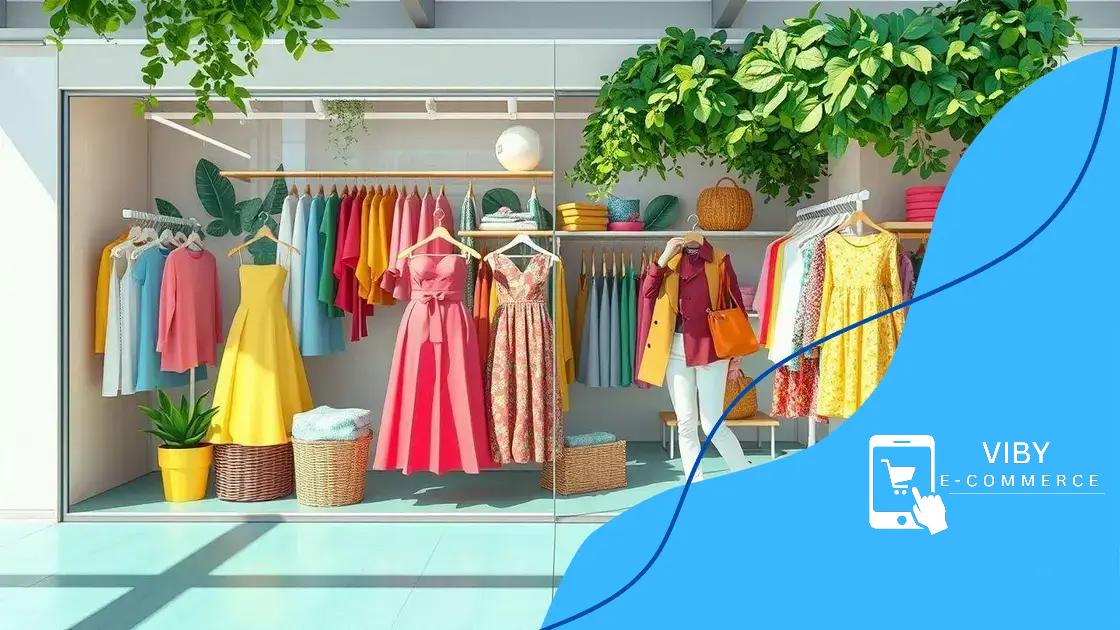Shein’s educational efforts in reducing textile waste

Shein’s educational efforts in reducing textile waste involve setting ambitious sustainability goals, fostering community engagement through workshops, and collaborating with environmental organizations to promote responsible consumer behavior.
Shein’s educational efforts in reducing textile waste are not only innovative but also essential in today’s fashion landscape. Have you ever considered how your shopping choices impact the environment? Here, we’ll delve into the initiatives Shein is undertaking to change the game.
Understanding Shein’s approach to textile waste
Understanding Shein’s approach to textile waste is key to recognizing its impact on the fashion industry. Shein is committed to reducing waste through various innovative strategies that not only benefit the environment but also educate consumers.
Innovative Waste Reduction Strategies
One of Shein’s main goals is to reshape how fashion is produced and consumed. By adopting efficient production techniques, the brand helps to minimize the amount of textile waste created. For example, Shein utilizes a model that combines fast fashion with sustainable practices.
- On-demand production to reduce overstock
- Advanced technology for precise fabric cutting
- Recycling and upcycling initiatives
- Partnerships with sustainable materials suppliers
An essential part of this approach is educating their customers about how they can contribute to sustainability. Shein aims to instill a sense of responsibility in its consumers regarding their shopping habits. By promoting sustainable choices, consumers can help decrease textile waste.
Consumer Education Initiatives
Shein has started several campaigns aimed at increasing awareness about textile waste. These initiatives include:
- Interactive online workshops about sustainable fashion
- Blog articles addressing the impact of textile waste
- Social media campaigns encouraging responsible consumption
Furthermore, Shein promotes transparency regarding its production methods. By highlighting its efforts, the brand encourages customers to make informed decisions when purchasing.Shein’s involvement in sustainability goes beyond mere marketing; it seeks to foster a culture of awareness.
Educational initiatives promoting sustainability
Shein is actively engaging in educational initiatives that promote sustainability in the fashion industry. These programs aim to inform consumers about the importance of reducing textile waste.
Workshops and Online Learning
One significant component of these initiatives is the implementation of workshops and online courses. These programs are designed to help participants understand the consequences of fast fashion. By learning about sustainable practices, consumers can make better choices.
- Topics include recycling and upcycling textiles.
- Strategies for responsible consumption.
- Insights from industry experts on sustainability.
Moreover, Shein partners with various organizations to create content that is both informative and engaging. These efforts not only educate the audience but also empower them to take action.
Awareness Campaigns
Another crucial aspect of Shein’s educational initiatives is the launch of awareness campaigns on social media. These campaigns reach a wide audience and inform followers about the effects of their fashion choices. By sharing stories and facts, Shein encourages dialogue about sustainability.
- Highlighting sustainable brands and materials.
- Showcasing success stories from eco-conscious consumers.
- Promoting labeling for sustainable products.
Through these efforts, Shein is dedicated to changing the narrative around fashion consumption. By prioritizing education, they hope to inspire responsible shopping habits and contribute to a more sustainable future.
Collaborations with environmental organizations

Shein is forging strong collaborations with environmental organizations to tackle the pressing issue of textile waste. These partnerships aim to combine resources and expertise to create a more sustainable fashion industry.
Strategic Partnerships
By working with renowned environmental groups, Shein increases its impact on sustainability efforts. These collaborations help raise awareness about the environmental problems posed by fast fashion. They also allow for the development of innovative solutions that specifically target waste reduction.
- Joint campaigns focused on recycling and upcycling apparel.
- Research projects aimed at developing sustainable materials.
- Community initiatives promoting responsible consumer behavior.
Such partnerships not only support Shein’s sustainability goals but also extend the reach of these organizations, bringing important messages to wider audiences.
Community Engagement Programs
Alongside these strategic initiatives, Shein is involved in community engagement programs. These initiatives often include local events designed to educate consumers on how they can contribute to reducing textile waste. Through workshops and hands-on activities, participants learn about sustainable fashion practices.
- Clothing drives to encourage recycling of old garments.
- Educational sessions on environmental impact.
- Collaborative events with schools and local businesses.
In summary, Shein’s commitment to collaboration with environmental organizations showcases their dedication to making a positive impact. By uniting efforts, they hope to inspire both consumers and industry leaders to prioritize sustainability.
Impact of educational programs on consumer behavior
Educational programs play a crucial role in shaping consumer behavior regarding sustainable fashion. By equipping individuals with knowledge about the impact of their choices, these programs encourage thoughtful consumption.
Changing Mindsets
One significant impact of Shein’s educational initiatives is the change in how consumers think about their purchases. Participants in these programs often report a greater awareness of issues such as textile waste and the carbon footprint of fast fashion. This newfound knowledge leads to more responsible shopping habits and encourages consumers to consider sustainability when choosing clothing.
- Informed decisions on choosing sustainable materials.
- Awareness about the importance of recycling and upcycling clothing.
- Understanding the environmental impact of fast fashion brands.
As consumers learn more about the fashion industry, they become empowered advocates for change.
Encouraging Sustainable Choices
The educational programs offered by Shein not only inform but also inspire individuals to make sustainable choices. Many participants express a desire to support brands that prioritize eco-friendly practices. By sharing success stories from other eco-conscious consumers, these programs create a sense of community and motivation.
- Setting goals for reducing personal clothing waste.
- Exploring local sustainable fashion options.
- Participating in clothing swap events to promote sharing.
By fostering this mindset, Shein’s educational initiatives ultimately contribute to a shift in consumer behavior. The ripple effect of well-informed consumers can lead to a more significant demand for sustainable practices across the entire fashion industry.
Future goals for sustainable practices at Shein
Shein is committed to a sustainable future and has set ambitious goals to enhance their practices. By aiming for more eco-friendly approaches, Shein seeks to tackle the ongoing challenges in the fashion industry.
Commitment to Sustainable Materials
One of Shein’s primary goals is to increase the use of sustainable materials. This includes sourcing organic cotton, recycled polyester, and innovative fabrics that minimize environmental impact. Such changes will not only reduce waste but also lower the overall carbon footprint of their products.
- Switching to 100% eco-friendly materials by 2025.
- Partnering with suppliers who prioritize sustainability.
- Researching new sustainable fabric technologies.
By making these changes, Shein aims to lead by example and encourage others in the industry to follow suit.
Enhancing Recycling Initiatives
Another goal involves strengthening their recycling initiatives. Shein plans to launch programs that facilitate the recycling of old garments, helping to keep clothing out of landfills. Through education and awareness, consumers will be encouraged to participate in this recycling effort.
- Implementing clothing take-back programs.
- Providing information on how to recycle clothes properly.
- Creating partnerships with recycling organizations.
These initiatives will not only support sustainable practices but also foster a sense of community and responsibility among consumers.
Transparency in Supply Chain
Shein also aims to improve transparency in its supply chain. By being open about manufacturing practices, they can build trust with consumers who value ethical standards. This includes sharing information about labor conditions and sourcing practices.
- Publishing regular sustainability reports.
- Engaging with stakeholders for feedback.
- Establishing clear guidelines for ethical sourcing.
These efforts reflect Shein’s dedication to creating a more sustainable fashion industry and drive meaningful changes in consumer behavior.
FAQ – Questions about Shein’s Educational Efforts in Reducing Textile Waste
What are Shein’s main goals for sustainability?
Shein aims to use 100% eco-friendly materials by 2025, enhance recycling initiatives, and improve transparency in its supply chain.
How does Shein educate consumers about sustainable practices?
Shein offers workshops, online learning, and social media campaigns to inform consumers about sustainable fashion and the importance of reducing textile waste.
What role do partnerships play in Shein’s sustainability efforts?
Shein collaborates with environmental organizations to develop innovative solutions, share resources, and promote responsible consumer behavior.
How can consumers participate in sustainable practices with Shein?
Consumers can engage in clothing recycling programs, attend educational workshops, and make informed choices by supporting sustainable products.





